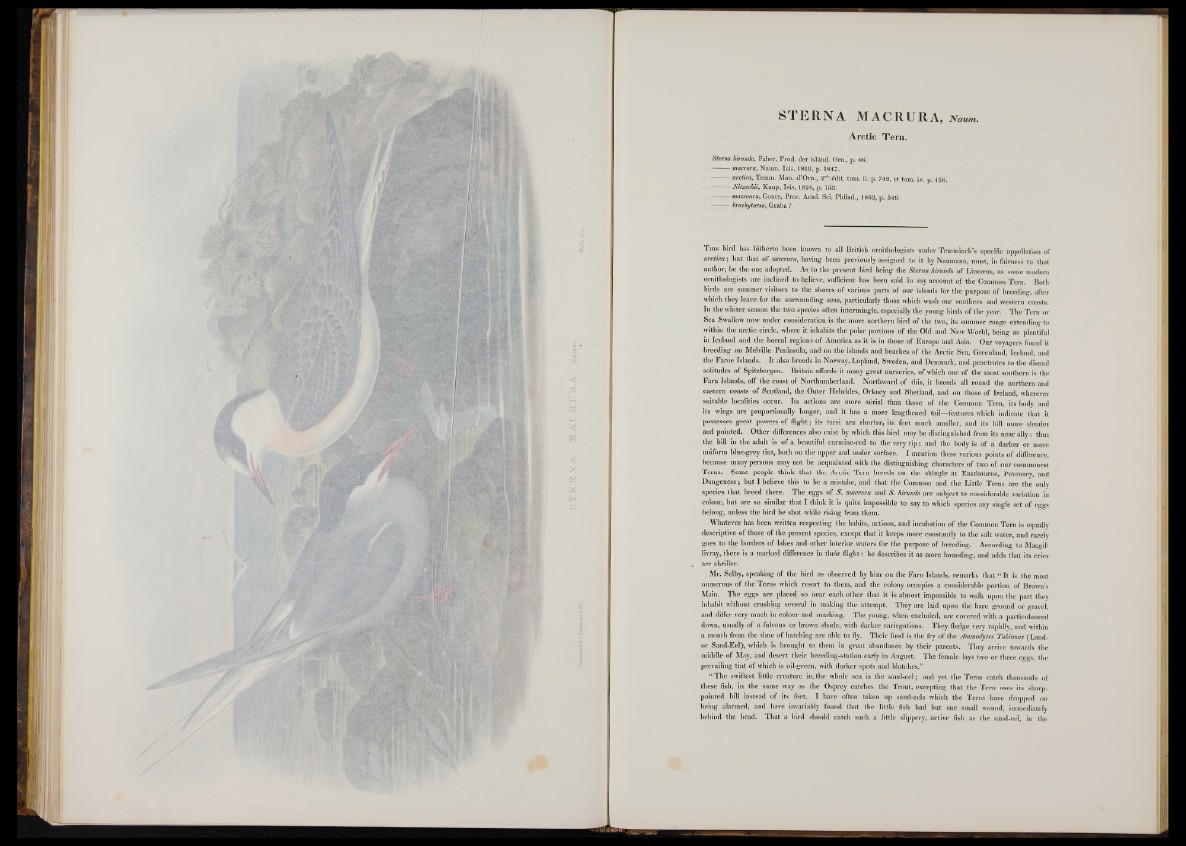
STERNA MACRURA, Naum.
Arctic Tern.
Sterna hirundo, Faber, Prod, der island. Orn., p. 88.
— :— macrura, Naum. Isis, 1819, p. 1847.
— arctica, Temm. Man. d’Om., 2"4’ 6dit. tom, ii. p. 742, et tom. iv. p. 458.
—; Nitzschii, Kaup, Isis, 1824, p. 153.
— macroura, Coues, Proc. Acad. S.ci. Philad., 1862, p. 549.
brachytarsa, Graba ?
T h is bird lias hitherto been known to all British ornithologists under Temminck’s specific appellation of
arctica; but that o f macrura, having been previously assigned to it by Naumann, must, in fairness to that
author, be the one adopted. As to the present bird being the Sterna hirundo o f Linnaeus, as some modern
ornithologists are inclined to believe, sufficient has been said in my account o f the Common Tern. Both
birds are summer visitors to the shores o f various parts o f our islands for the purpose o f breeding, after
which they leave for the surrounding seas, particularly those which wash our southern and. western coasts.
In the winter season the two species often intermingle, especially the young birds o f the year. The Tern or
Sea Swallow now under consideration is the more northern bird o f the two, its summer range extending to
within the arctic circle, where it inhabits the polar portions of the Old and New World, being as plentiful
in Iceland and the boreal regions o f America as it is in those o f Europe and Asia. Our voyagers found it
breeding on Melville Peninsula, and on the islands and beaches o f the Arctic Sea, Greenland, Iceland, and
the Faroe Islands. It also breeds in Norway, Lapland, Sweden, and Denmark, and penetrates to the dismal
solitudes of Spitzbergen. Britain affords it many great nurseries, o f which one o f the most southern is the
Fam Islands, off the coast o f Northumberland. Northward o f this, it breeds all round the northern and
eastern coasts o f Scotland, the Outer Hebrides, Orkney and Shetland, and on those o f Ireland, wherever
suitable localities occur. Its actions are more aerial than those o f the Common Tern, its body and
its wings are proportionally longer, and it has a more lengthened tail— features which indicate that it
possesses great powers o f flight; its tarsi are shorter, its feet much smaller, and its bill more slender
and pointed. Other differences also exist by which this bird may be distinguished from its near ally: thus
the bill in the adult is o f a beautiful carmine-red to the very t ip ; and the body is o f a darker or more
uniform blue-grey tint, both on the upper and under surface. I mention these various points o f difference,
because many persons may not be acquainted with the distinguishing characters o f two of our commonest
Terns. Some people think that the Arctic Tern breeds on the shingle at Eastbourne, Pevensey, and
Dungeness; but I believe this to be a mistake, and that the Common and the Little Terns are the only
species that breed there. The eggs o f S . macrura and S . hirundo are subject to considerable variation in
colour, but are so similar that I think it is quite impossible to say to which species any single set o f eggs
belong, unless the bird be shot while rising from them.
Whatever has been written respecting the habits, actions, and incubation of the Common Tern is equally
descriptive o f those of the present species, except that it keeps more constantly to the salt water, and rarely
goes to the borders o f lakes and other interior waters for the purpose o f breeding. According to Macgil-
livray, there is a marked difference in their flight: he describes it as more bounding, and adds that its cries
are shriller.
Mr. Selby, speaking of the bird as observed by him on the Farn Islands, remarks that “ It is the most
numerous o f the Terns which resort to them, and the colony occupies a considerable portion o f Brown’s
Main. The eggs are placed so near each other that it is almost impossible to walk upon the part they
inhabit without crushing several in making the attempt. They are laid upon the bare ground or gravel,
and differ very much in colour and marking. The young, when excluded, are covered with a particoloured
down, usually o f a fulvous or brown shade, with darker variegations. They fledge very rapidly, and within
a month from the time o f hatching are able to fly. Their food is the fry o f the Ammodytes Tabianus (Land-
or Sand-Eel), which is brought to them in great abundance by their parents. They arrive towards the
middle o f May, and desert their breeding-station early in August. The female lays two or three eggs, the
prevailing tint o f which is oil-green, with darker spots and blotches.”
“ The swiftest little creature in.the whole sea is the sand-eel; and yet the Terns catch thousands o f
these fish, in the same way as the Osprey catches the Trout, excepting that the Tern uses its sharp-
pointed bill instead o f its feet. I have often taken up sand-eels which the Terns have dropped on
being alarmed, and have invariably found that the little fish had but one small wound, immediately
behind the head. That a bird should catch such a little slippery, active fish as the sand-eel, in the